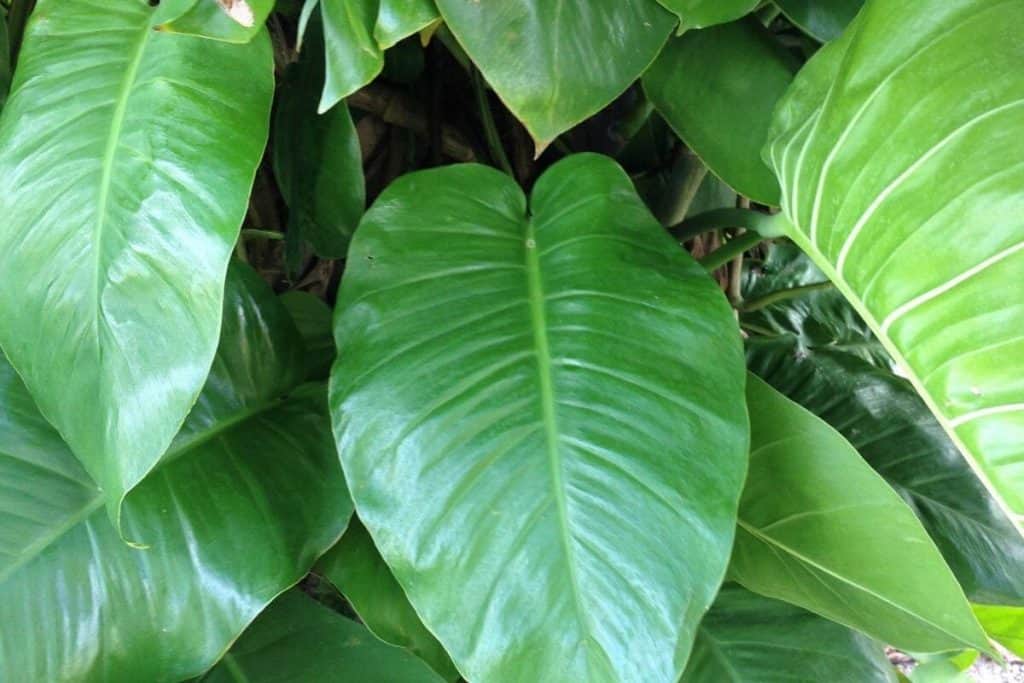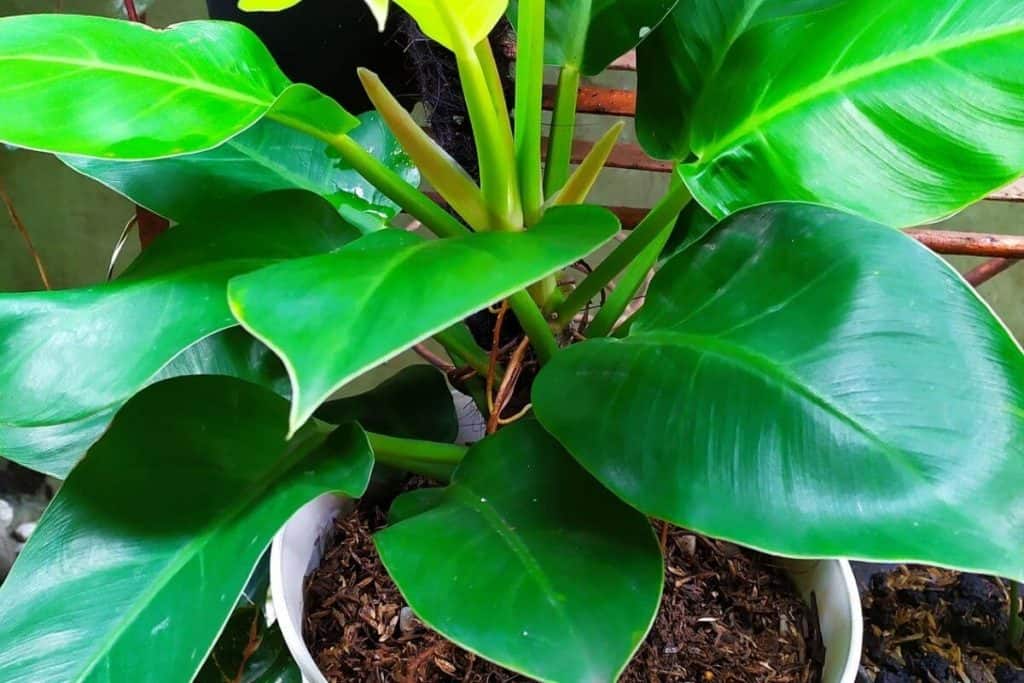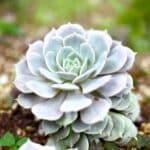There are over 450 varieties of the Philodendron. If you're a fan of large leafy indoor tropical plants, then the Philodendron Giganteum should be your favorite.
Philodendron Giganteum is one of the common varieties of Philodendron and can be purchased at almost any nursery worldwide.
If you are interested in adding that lush, tropical feel that Philodendron giganteum gives to any space, you should be interested in this post on Philodendron giganteum care.
The Philodendron giganteum thrives in bright, indirect sunlight and should only be watered when the top 2 inches of the soil is dry. The Philodendron giganteum should be planted in well-drained, loamy, and rich in organic matter.
Now, let’s get into the particulars on how to care for Philodendron giganteum.
Table of Contents
What is Philodendron Giganteum?
Before we get into the care requirements of Philodendron giganteum, we must examine this tropical plant; this will help you identify it.
Philodendron giganteum is native to the tropical forests of South America and was discovered in the mid-19th century. The Philodendron giganteum belongs to the Araceae family.
As the name suggests (giganteum), this plant is characterized by lustrous rich green fanning leaves. Sometimes it is called Philodendron Giganteum Elephant Ear because the leaves look like an elephant's ear.
The Philodendron giganteum being a big plant, can grow 10 to 15 feet in length and 6 to 8 feet in width. The leaves can grow up to 2 feet long under ideal conditions. Its size makes it the perfect filler plant for bare spaces and works well in substantial living spaces.
As mentioned earlier, the Philodendron giganteum is a common Philodendron variety; thus, you can get it in most nurseries and online stores.
Just like most Philodendron varieties, the Philodendron giganteum has heart-shaped green leaves. Underneath, the leaves have midrib with veins that comes to life when light falls on them.
Another way to identify the Philodendron giganteum is through its vinelike appearance. The leaf stalks of the Philodendron giganteum are stacked up close, making the stem invisible.
Related Post: Is Philodendron Safe For Cats?
Philodendron Giganteum Care and Growing Guide

Like most philodendron varieties, the Philodendron giganteum is a beginner-friendly plant, making it the ideal plant if you're just trying out gardening.
The trick to taking care of the Philodendron giganteum is to simulate or replicate the natural environment of the tropical plant. This means providing the plant with plenty of warmth, bright light, and moisture. Now, let's get to the care requirements of the Philodendron giganteum.
Philodendron Giganteum Water Requirements
The Philodendron giganteum is prone to be overwatered; thus, you need to find a balance watering regime. While the Philodendron giganteum is prone to be overwatered, the plant cannot survive prolonged dry periods.
To keep your Philodendron giganteum healthy, water it once every seven days during the spring and summer season, which is the plant's growth phase, and ease out on watering during the winter season (about once in 10 days should be sufficient).
You might not need to follow the watering schedule at all times. Before you water, touch the topsoil; if it feels moist, you should skip watering and wait until 2 inches of the topsoil is dry.
Also, your watering schedule should be based on the weather of the place the plant is housed. For instance, if you live in the tropics and grow Philodendron giganteum outdoors in the ground, you can water it every other day.
Philodendron Giganteum Light Requirements
As mentioned, the trick to caring for the Philodendron giganteum is to replicate or simulate its natural growing conditions in the tropics. Most Philodendron varieties grow in the shade of high vegetation, out of reach of direct sunlight.
It follows that the Philodendron giganteum will thrive when placed in a spot with a lot of filtered light. For the perfect location, place your Philodendron giganteum next to the east or west window where the mild morning or afternoon sun will not harm it.
Avoid direct sunlight as it will scorch the leaves of the Philodendron giganteum.
Related Post: Philodendron Thai Sunrise Vs Golden Goddess
Soil Requirements
Philodendron giganteum needs light, airy and loose soil through which water drains quickly.
The soil needs to be rich in organic matter and sphagnum peat moss. To achieve this, you can easily buy a cactus or succulent mix and add perlite and peat moss to it. You can also improve the richness of the soil by adding materials like brick bits, coconut husk, bark, etc.
Most experienced gardeners recommend that Philodendron giganteum be grown outdoors straight in the ground. Find a spot with quick-draining soil rich in organic matter.
You can achieve this by adding plenty of leaf mulch and sterile compost etc., to the soil. This will help the soil retain moisture.
Potting and Repotting Philodendron Giganteum
While it is recommended that the Philodendron giganteum be grown outdoors, you might not always have the resources. If you choose to grow Philodendron giganteum in a container or pot, ensure that the container has drainage holes.
You should get a container that will fit the plant perfectly since the Philodendron giganteum doesn't like to be repotted often, being a plant that likes rootbound. The Philodendron giganteum should only be when the roots start coming out through the drainage holes.
When this happens, wait until the early spring before you repot the plant. This will give the newly repotted Philodendron giganteum enough time to adapt to the new circumstances before the period of intensive growth begins.
Philodendron Giganteum Fertilizer Requirements
While most Philodendron varieties might survive without fertilizer, this doesn’t apply to the Philodendron giganteum. Being a large plant, the Philodendron giganteum consumes nutrients rapidly from the soil and needs regular fertilization.
Fertilize your Philodendron giganteum at least twice a month with liquid fertilizer during the growing season.
Liquid fertilizers are best suited for large plants like Philodendron giganteum since this type of fertilizer provides rapid nutrients to the plant, which is more in line with the accelerated metabolism of this plant.
You can also feed your Philodendron giganteum with organic fertilizers like worm castings or mature compost at the beginning of the growing season. This should provide adequate nutritional support for the plant throughout the season.
Related Post: Philodendron Cordatum Vs Hederaceum
Humidity Requirements
The Philodendron giganteum being a plant with a tropical origin, is already acclimatized to warm and humid air. Thus, growing this plant means that you've to try and provide it with a similar humidity level it is accustomed to.
The Philodendron giganteum will thrive best with a humidity level of 60% and above. And this is precisely why it is challenging growing this plant indoors since the humidity level in most homes is about 30%.
You can try misting the leaves of the Philodendron giganteum several times a week to raise the humidity level. Use a damp cloth or wet sponge to wipe the leaves. A more practical approach is to use a humidifier to control the humidity level of the plant.
Note that dust and other accumulated particles on the plants can reduce their humidity level, thus constantly cleaning them. This will not only raise the humidity levels, but it’s also a great way to refresh the plant and provide additional moisture.
Temperature Requirements
The ideal temperature for the Philodendron giganteum should range between 65 to 80°F (15 to 28 °C).
While this plant can survive temperatures below and above the range mentioned here, once the temperature drops to 55°F (13°C) and below, the plant will show signs of hypothermia.
How to Prune Philodendron Giganteum
Well, the beauty of the Philodendron giganteum lies in the unrestrained, bushy formation of its leaves. Pruning this plant will probably subtract from its natural beauty.
Instead of pruning the Philodendron giganteum, regularly remove damaged, aged, or diseased leaves to keep the plant looking good. You also do not need to shorten the stem since the plant grows at its own pace.
How to Propagate Philodendron Giganteum

Most climbing Philodendron varieties can easily be propagated, and the Philodendron giganteum is no different.
The only downside to propagating the Philodendron giganteum by stem cuttings is that this plant grows from a single stem for a very long time before the central stem elongates enough to take a cutting.
Once this plant gets to that stage, you can easily propagate it. To propagate the Philodendron giganteum, follow the steps outlined below:
- Water the Philodendron giganteum and wait for an hour until the plant absorbs it and the aerial roots become flexible.
- Next, fill a pot with drainage holes with little coarse gravel or a few tile pieces at the bottom. Then with layers of coconut shells or bark and a mixture of substrate and perlite or sand in the order mentioned.
- Now, cut off the top of the stem at a 45-degree angle, just below the nodes.
- Leave the stem cutting in a shady place for 2-3 hours to dry. Alternatively, dip the stem cutting in hormone powder to stimulate root development.
- Then insert the cutting in the prepared pot and bend the aerial roots keeping it inside the container.
- Lastly, fill the pot with substrate and water regularly. Make sure to place the new plant in a warm, bright, and shaded place.
Related Post: Brazil Pothos Vs Philodendron
Common Pests That Affect Philodendron Giganteum
One of the reasons why the Philodendron giganteum is a perfect plant for beginners is probably because it is almost pest-free.
The only time that the Philodendron giganteum suffers from pest infestation is when it is in a weak state or not being cared for in the right way. The common pests that attack the Philodendron giganteum are aphids, mealybugs, or thrips.
Once the Philodendron giganteum is adequately cared for, you may never deal with any pest infestation. To reduce and prevent pest infestation, treat the leaves of Philodendron giganteum with a neem oil solution.
Neem oil is effective as a preventive measure and can be used as a treatment for an already infected plant.
Chemically created insecticides should only be used when the pest infestation is quite severe or when there is no alternative safe way of dealing with the pests.
Philodendron Giganteum Problems
The Philodendron giganteum also has low chances of being infected with diseases and bacteria.
At first glance, this beautiful, exotic plant, with its impressive size, looks like a plant prone to pests and diseases, but actually, the reverse is the case. The Philodendron giganteum is surprisingly a very hardy and adaptable plant.
The Philodendron giganteum only becomes prone to diseases due to improper care or very unfavorable conditions for growth.
The cause of a diseased Philodendron giganteum ranges from excessive or insufficient watering, improper lighting, and frequent misting. We will examine some of these causes below.
1. Frequent Misting
While misting is a way to raise the humidity level of your Philodendron giganteum, it carries with it the danger and possibility of fungal infections.
Yes, the Philodendron giganteum is a humid-loving plant, but excessive moisture on the leaves gives room for various parasitic fungi that will take over the leaves and stems.
Most experienced gardeners recommend that the best way to raise the humidity level of your Philodendron giganteum is by installing a humidifier. If you must mist this plant, always do it in the morning to make the water evaporate during the day.
Mist sparingly, and if the leaves are too wet, dry them with a cloth to prevent the water from accumulating on them.
2. Underwatering
The worst thing you can do to the humid-loving Philodendron giganteum is to leave it for an extended period without water.
While this plant can survive short periods of drought, long periods of droughts will result in tormented, twisted, and dry leaves with brown tips.
The good news is that this plant will recover as soon as you water it, provided that the drought period does not affect its overall growth.
3. Low Light
While the Philodendron giganteum should be placed in filtered light, you don't want to put the plant in completely shady locations.
This will result in elongated stalks, pale foliage, slow growth, and scattered, sparse leaf arrangement. In the winter season, you should place this plant under artificial lighting.
Frequently Asked Questions
How Much Light Does a Philodendron Giganteum Need?
Philodendron giganteum will thrive when placed in a spot with a lot of filtered light, like next to the east or west-facing window. In low light conditions, you may have to use artificial lighting for the plant.
Does Philodendron Giganteum Climb?
Yes. The Philodendron giganteum falls under the category of climbing Philodendrons.
Is Philodendron Giganteum Rare?
No, the Philodendron giganteum is not a rare variety in the Philodendron species. This plant can be purchased in almost all nurseries worldwide or even online.
Does Philodendron Giganteum Like to Be Root Bound?
Yes. The Philodendron giganteum likes to be rootbound; thus, it shouldn't be transplanted or repotted regularly.
Related Post: Heartleaf Philodendron Care




